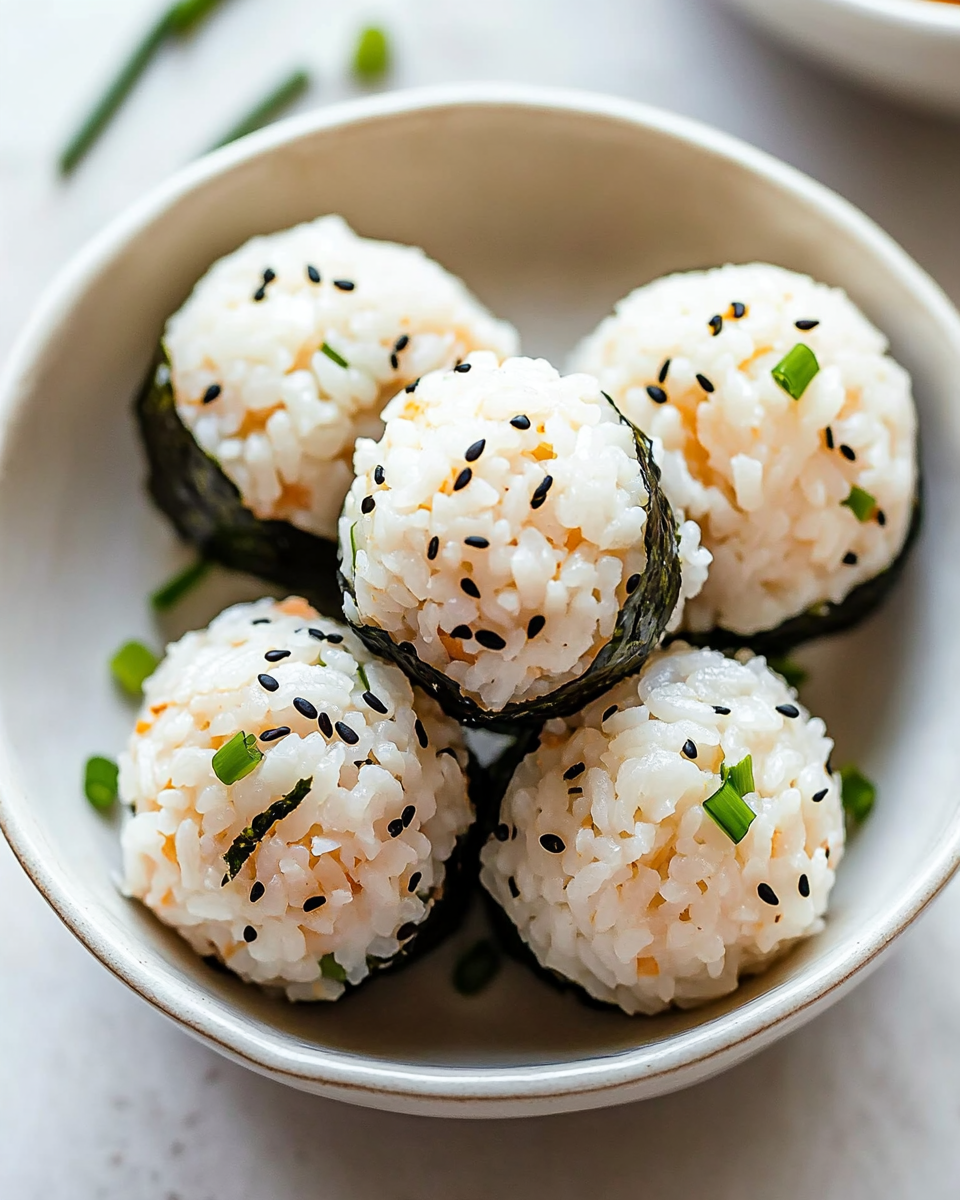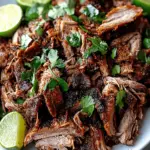The beauty of Tuna Rice Balls lies in their simplicity and versatility. Made with just a few ingredients, they deliver bold umami flavors and are perfect for packed lunches, quick snacks, or even a light dinner. The creamy tuna filling, paired with fragrant sesame and the gentle crunch of seaweed, makes each bite incredibly satisfying.
These rice balls are not only visually appealing but also fun to assemble, especially with kids. Whether you’re planning a bento box, prepping for a picnic, or just craving a Japanese-inspired treat, these Tuna Rice Balls are a wholesome and delicious option you’ll find yourself making again and again.
Full Recipe:
Ingredients:
-
2 cups cooked white rice (cooled to room temperature)
-
1 can (5 oz) tuna in water, drained
-
2 tablespoons Japanese mayonnaise
-
1 teaspoon soy sauce
-
1/2 teaspoon sesame oil
-
1 tablespoon chopped green onions (optional)
-
Salt to taste
-
1 tablespoon roasted sesame seeds
-
1 sheet nori (seaweed), cut into strips
-
Plastic wrap for shaping
Directions:
-
In a bowl, flake the drained tuna and mix it with Japanese mayo, soy sauce, sesame oil, and green onions. Adjust salt to taste.
-
Divide the cooked rice into 6 equal portions.
-
Take one portion of rice and flatten it in your palm using plastic wrap.
-
Add a spoonful of the tuna mixture to the center, then mold the rice around the filling to form a ball.
-
Roll the rice ball in sesame seeds for extra flavor and texture.
-
Wrap a small strip of nori around each rice ball for a traditional touch.
-
Repeat for the remaining portions. Serve chilled or at room temperature.
Prep Time: 15 minutes | Cooking Time: 0 minutes | Total Time: 15 minutes
Kcal: 160 kcal | Servings: 6 balls
Tuna Rice Balls: A Nutritious and Convenient Meal Option
Tuna rice balls are a delicious, versatile, and easy-to-make meal that draws inspiration from Japanese onigiri while offering a unique twist tailored to modern home cooks. These compact, handheld bites are made primarily with cooked rice and canned tuna, making them an excellent option for busy individuals and families alike. They’re a perfect blend of simplicity and satisfaction, offering a balanced mix of protein and carbohydrates. Whether you’re preparing lunch for your children, packing snacks for a road trip, or looking for a quick post-workout meal, tuna rice balls deliver flavor, nutrition, and convenience.
While onigiri has long been a staple in Japanese bento boxes, the Western take on tuna rice balls adds new flavors and textures that cater to a broader audience. The core idea remains the same: combine rice with a flavorful filling, form it into a ball or triangle, and enjoy. The inclusion of canned tuna offers not just great taste but also practical benefits. Tuna is rich in lean protein and omega-3 fatty acids, which support heart health, brain function, and muscle repair. When paired with rice a gentle, gluten-free carbohydrate source it creates a wholesome, satisfying meal that can be eaten hot or cold.
Why Tuna Rice Balls Are the Ultimate Make-Ahead Meal
One of the best aspects of tuna rice balls is their ability to be made ahead of time and stored in the refrigerator. They hold their shape well, maintain their flavor even when chilled, and require no reheating. This makes them ideal for packed lunches, picnics, meal prepping, or even quick weeknight dinners. If you’re managing a busy lifestyle and don’t want to compromise on eating healthy, these rice balls can be your go-to solution.
Additionally, the recipe can be scaled up or down depending on your needs. Preparing a batch on Sunday evening can save you precious time throughout the week. Each rice ball serves as a portable, mess-free meal, perfect for kids and adults alike. You can easily wrap them in parchment or reusable beeswax wraps for an eco-friendly, on-the-go snack.
A Customizable Canvas for Every Palate
Another fantastic thing about tuna rice balls is how customizable they are. You can stick to the classic combination of tuna and rice or get creative by incorporating different herbs, vegetables, and seasonings. Add chopped green onions, diced cucumbers, or grated carrots for crunch and freshness. For a spicy twist, a bit of sriracha or wasabi mixed into the tuna can give the rice balls a flavorful kick. You could even incorporate mayonnaise, avocado, or cheese for a creamier texture and richer taste.
Seaweed wrappers (nori) can be used to enhance both the visual appeal and the flavor, offering that signature umami taste that so many love. Toasted sesame seeds, furikake seasoning, or crushed peanuts can also be sprinkled on top to add additional layers of taste and crunch. These add-ins allow you to cater to dietary needs, taste preferences, or simply make use of whatever ingredients you already have at home.
A Kid-Friendly Favorite
For parents, tuna rice balls can be a game-changer. Kids are often picky eaters, but the soft texture and mild flavor of tuna rice balls make them very appealing. Shaped into fun forms or paired with dipping sauces like soy sauce or sweet chili, they become an exciting lunchbox feature. They’re nutritious enough to keep your child energized and focused, without any processed sugars or artificial ingredients.
Getting kids involved in the preparation process can also be a fun and educational activity. Let them help shape the rice or mix the tuna filling cooking together is a great way to introduce children to the joy of healthy eating and basic culinary skills.
Perfect for Weight Management and Special Diets
Because tuna rice balls are made with simple, whole ingredients, they naturally fit into many special diets. They’re gluten-free, dairy-free (unless cheese is added), and can be modified to be keto-friendly with the right rice alternatives like cauliflower rice. If you’re counting calories or managing macronutrients, it’s easy to measure your portion size and adjust ingredients accordingly.
Tuna is a particularly smart choice for those looking to build muscle or reduce body fat. It’s low in calories but high in protein, meaning it helps you feel full longer while supporting lean muscle mass. Brown rice or quinoa can also be used instead of white rice to increase the fiber content, further improving digestion and satiety.
The Cultural Inspiration Behind Tuna Rice Balls
Though the recipe is adapted for a Western kitchen, it’s worth acknowledging the cultural roots of the rice ball. Onigiri, which dates back over a thousand years in Japan, has always been a beloved food due to its simplicity and portability. Soldiers and travelers used to carry onigiri as a reliable food source. It was easy to prepare and store, much like a sandwich in Western cultures.
In modern Japan, onigiri is a staple in convenience stores and homes alike. By making tuna rice balls, we tap into this timeless tradition while adding our own spin. This fusion of culture and culinary creativity makes the dish even more enjoyable and meaningful.
Serving Suggestions and Pairings
While tuna rice balls can certainly stand on their own as a meal or snack, they also pair well with a variety of sides and beverages. Serve them alongside a miso soup, seaweed salad, or a light vegetable broth for a more complete meal. They also work wonderfully with green tea, iced matcha, or a citrusy drink like lemonade or cucumber water.
If you’re entertaining guests, consider arranging them on a platter with different dipping sauces and garnishes. It creates an interactive experience where guests can mix and match according to their tastes. A sprinkle of chili flakes or a dollop of spicy mayo can add heat, while soy sauce or ponzu brings salt and zest.
Storing and Reheating Tips
To keep your tuna rice balls fresh, store them in an airtight container in the refrigerator for up to 3 days. For longer storage, wrap them individually in plastic wrap and place them in a freezer bag to freeze for up to a month. When you’re ready to eat, you can thaw them overnight in the fridge or microwave for a short burst if you prefer them warm.
If using nori or other toppings, consider adding them just before serving so they retain their texture and flavor. Moisture from the rice can cause seaweed to become soggy over time, so keep toppings and sauces separate until mealtime if you’re storing ahead.
Conclusion:
Tuna rice balls are more than just a quick bite they’re a reflection of how simple ingredients can be transformed into something satisfying, healthy, and exciting. With their roots in Japanese tradition and a modern twist that makes them even more adaptable, these compact snacks are a brilliant addition to any mealtime lineup.
Whether you’re looking to simplify your weekly meal prep, feed a family with diverse tastes, or explore global culinary traditions in your own kitchen, tuna rice balls deliver every time. They’re affordable, versatile, and absolutely delicious proof that great food doesn’t have to be complicated.
So next time you’re wondering what to make with that can of tuna sitting in your pantry, give this recipe a try. You might just discover your new favorite comfort food one that travels well, satisfies hunger, and brings a smile to every face at the table.






